Tamil Nadu
| Tamil Nadu தமிழ் நாடு |
||
|---|---|---|
| State of India | ||
|
||
| Motto: Truth alone Triumphs | ||
| Anthem: "Invocation to Tamil Mother"# | ||
 Location of Tamil Nadu (marked in red) in India |
||
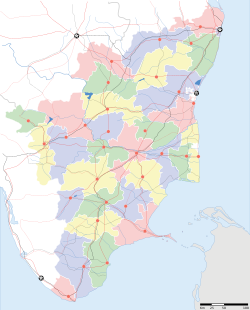 Map of Tamil Nadu |
||
| Coordinates: 13.09°N 80.27°ECoordinates: 13.09°N 80.27°E | ||
| Country | ||
| Region | South India | |
| Established | 26 January 1950† | |
| Capital and largest city | Chennai | |
| Districts | 32 | |
| Government | ||
| • Governor | Konijeti Rosaiah | |
| • Chief Minister | J Jayalalithaa(AIADMK) | |
| • Legislature | Tamil Nadu Legislative Assembly (234 member Unicameral) | |
| • High Court | Madras High Court | |
| Area | ||
| • Total | 130,058 km2 (50,216 sq mi) | |
| Area rank | 11th | |
| Population (2011)[1] | ||
| • Total | 72,147,030 | |
| • Rank | 6th | |
| • Density | 550/km2 (1,400/sq mi) | |
| Demonym(s) | Tamizhar | |
| Time zone | IST (UTC+05:30) | |
| ISO 3166 code | IN-TN | |
| HDI | ||
| HDI rank | 6th (2011)[3] | |
| Literacy Rate | 80.33 % (2011 census)[4] | |
| Official language | Tamil | |
| Website | tn.gov.in | |
| ^† Established in 1773; Madras State was formed in 1950 and renamed as Tamil Nadu on 14 January 1969[5] ^# Jana Gana Mana is the national anthem, while "Invocation to Tamil Mother" is the state song/anthem. | ||
| Language | Tamil |
|---|---|
| Song | "Invocation to Goddess Tamil" |
| Dance | Bharathanattiyam |
| Animal | Nilgiri tahr |
| Bird | Emerald dove |
| Flower | Gloriosa lily |
| Fruit | Jackfruit |
| Tree | Palm tree |
| Sport | Kabaddi |
| Part of a series on |
| History of Tamil Nadu |
|---|
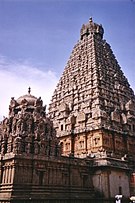 |
Tamil Nadu is the eleventh largest state in India by area and the sixth most populous state in India. The state was ranked sixth among states in India according to the Human Development Index in 2011.[3][8] Tamil Nadu is the second largest state economy in India with ₹4789 billion (US$72 billion) in gross domestic product.[9] The state has the highest number (10.56 per cent) of business enterprises and stands second in total employment (9.97 per cent) in India,[10] compared to the population share of about 6 per cent. Tamil Nadu was ranked as the third most developed state in India based on a "Multidimensional Development Index" in a 2013 report published by a panel headed by current RBI governor Raghuram Rajan.[11] Its official language is Tamil, which is one of the longest surviving classical languages in the world.[12]
Tamil Nadu is home to many natural resources, classical arts, classical music, classical literature, Hindu temples of Dravidian architecture, hill stations, beach resorts, multi-religious pilgrimage sites, and eight UNESCO World Heritage Sites.[13][14]
Contents
- 1 History
- 1.1 Prehistory
- 1.2 Indus valley script between 2000 and 1500 BC
- 1.3 Sangam Period (300 BC – AD 300)
- 1.4 Bhakti Movement
- 1.5 Medieval Period (600–1300)
- 1.6 Vijayanagar and Nayak period (1336–1646)
- 1.7 Power Struggles of the 18th century (1692–1801)
- 1.8 During British rule (1801–1947)
- 1.9 India (1947–present)
- 2 Geography
- 3 Flora and fauna
- 4 National and state parks
- 5 Climate
- 6 Governance and administration
- 7 Administrative subdivisions
- 8 Politics
- 9 Demographics
- 10 Education
- 11 Culture
- 12 Economy
- 13 Infrastructure
- 14 Sports
- 15 Tourism
- 16 See also
- 17 Notes
- 18 References
- 19 External links
History
Main article: History of Tamil Nadu
Prehistory
Archaeological evidence . Archeologists from the Archaeological Survey of India (ASI) unearthed 169 clay urns containing human skulls, skeletons, bones, husks, grains of rice, charred rice and celts of the Neolithic period, 3,800 years ago.[15] The ASI archaeologists have proposed that the script used at that site is "very rudimentary" Tamil Brahmi.[16] Adichanallur has been announced as an archaeological site for further excavation and studies.[17] About 60 per cent of the total epigraphical inscriptions found by the ASI in India are from Tamil Nadu, and most of these are in the Tamil language.[18] Virumandi Andithevar, of the Piramalai Kallar community from the Tamil Nadu region of southern India, was identified by the Genographic Project as one of the direct descendants of the first modern human settlers in India. His Y belongs to Haplogroup C and he carries the M130 marker which defines the first migrants to South East Asia and Australia from the African coast 60,000 years ago; more than half of Australian Aborigines also carry the M130 gene.[19] Mythical traditions dictate that Lord Shiva himself taught sage Agastya this language.[20][21][22][23][24][25][26][27] Sage Agastya is considered to be the father of Tamil literature and compiled the first Tamil grammar called Agathiyam, but the scripts of Agathiyam no longer exist.[28]Indus valley script between 2000 and 1500 BC
Neolithic people of the Tamil country spoke a Dravidian language.The discovery of a Neolithic stone celt, a hand-held axe, with the Indus script on it at Sembian-Kandiyur in Tamil Nadu is, according to Iravatham Mahadevan, "Stone axe with Indus Valley script found near Mayiladuthurai,Tamil Nadu was a major discovery because for the first time a text in the Indus script has been found in the State on a datable artefact, which is a polished neolithic celt. He estimated the date of the artefact with the script to be around 1500 BC.[29]Sangam Period (300 BC – AD 300)

Sage Agastya father of Tamil literature, Sangam period
Three dynasties, namely the Chera, Chola and Pandya, ruled the area of present-day Tamil Nadu and Kerala. The Chera ruled the whole of present-day Kerala and parts of western Tamil Nadu comprising Coimbatore, Dharmapuri, Karur, Salem and Erode districts from the capital of Vanchi Muthur (thought to be modern day Karur). The Chola dynasty ruled the northern and central parts of Tamil Nadu from their capital, Uraiyur; and the Pandya dynasty ruled southern Tamil Nadu, from capitals at Korkai and Madurai.
All three dynasties had extensive trade relationships with Rome, Greece, Egypt, Ceylon, Phoenicia, Arabia, Mesopotamia and Persia. Trade flourished in commodities such as spices, ivory, pearls, beads and gems. Chera traded extensively from Muziris on the west coast, Chola from Arikamedu and Puhar and Pandya through Korkai port. A Greco-Roman trade and travel document, the Periplus of the Erythraean Sea (c. AD 60 – 100) gives a description of the Tamil country and its ports.
Besides these three dynasties, the Sangam era Tamilakam (Tamil homeland) was also divided into various provinces named 'nadu', meaning 'country'. Sangam literature refers these provinces as "koduntamil mandalam" which were not exactly political or socio-cultural units but linguistic agglomerations like Kongu Nadu, Puzhinadu, Thondai Nadu, Nanjilnadu, Ay Nadu and Venadu.
Between the 3rd and 6th centuries AD, the three Tamil kingdoms were overwhelmed by the Kalabhras. The period of their rule is sometimes referred to as the "Dark Age" in Tamil history and little is known about it. The Kalabhras were expelled by the Pallavas, Mutharaiyar, Badami Chalukyas and Pandyas in the 6th century.
Bhakti Movement
Main article: Bhakti Movement
The Bhakti movement originated in Tamil Speaking region of south India and spread northwards through India. The Bhakti Movement was a rapid growth of bhakti beginning in this region with the Saiva Nayanars (4th-10th centuries)[30] and the Vaisnava Alvars who spread bhakti poetry and devotion .[30][31] The Alwars and Nayanmars were instrumental in propagating the Bhakti tradition.Medieval Period (600–1300)

Kallanai or Grand Anicut, an ancient dam built on the Kaveri River in Tiruchirappalli by Karikala Chola around the 2nd century AD [32][33][34][35]
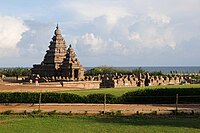
Shore Temple built by the Pallavas at Mamallapuram during the 8th century, now a UNESCO World Heritage Site
Much later, the Pallavas were replaced by the Chola dynasty as the dominant kingdom in the 9th century and they in turn were replaced by the Pandyan Dynasty in the 13th century. The Pandyan capital Madurai was in the deep south away from the coast. They had extensive trade links with the south east Asian maritime empires of Srivijaya and their successors, as well as contacts, even formal diplomatic contacts, reaching as far as the Roman Empire. During the 13th century, Marco Polo mentioned the Pandyas as the richest empire in existence. Temples such as the Meenakshi Amman Temple at Madurai and Nellaiappar Temple at Tirunelveli are the best examples of Pandyan temple architecture.[37] The Pandyas excelled in both trade and literature. They controlled the pearl fisheries along the south coast of India, between Sri Lanka and India, which produced some of the finest pearls in the known ancient world.
Chola Empire
Main article: Chola dynasty

The Chola Empire at its greatest extent, during the reign of Rajendra Chola I in 1030
The Cholas were prolific temple builders right from the times of the first medieval king Vijayalaya Chola. These are the earliest specimen of Dravidian temples under the Cholas. His son Aditya I built several temples around the Kanchi and Kumbakonam regions. The Cholas went on to becoming a great power and built some of the most imposing religious structures in their lifetime and they also renovated temples and buildings of the Pallavas, acknowledging their common socio-religious and cultural heritage. The celebrated Nataraja temple at Chidambaram and the Sri Ranganathaswami Temple at Srirangam held special significance for the Cholas which have been mentioned in their inscriptions as their tutelary deities. Rajaraja Chola I and his son Rajendra Chola built temples such as the Brihadeshvara Temple of Thanjavur and Brihadeshvara Temple of Gangaikonda Cholapuram, the Airavatesvara Temple of Darasuram and the Sarabeswara (Shiva) Temple, also called the Kampahareswarar Temple at Thirubhuvanam, the last two temples being located near Kumbakonam. The first three of the above four temples are titled Great Living Chola Temples among the UNESCO World Heritage Sites.
Architecture from Chola period From left to right: Airavatesvara Temple at Darasuram; Natarajan, Shiva as celestial dancer; and Parvathi, the consort of Shiva
Vijayanagar and Nayak period (1336–1646)
Main article: Vijayanagara Empire
The Muslim invasions of southern India triggered the establishment of the Hindu Vijayanagara Empire with Vijayanagara
in modern Karnataka as its capital. The Vijayanagara empire eventually
conquered the entire Tamil country by c. 1370 and ruled for almost two
centuries until its defeat in the Battle of Talikota in 1565 by a confederacy of Deccan sultanates. Subsequently, as the Vijayanagara Empire went into decline after the mid-16th century, many local rulers, called Nayaks,
succeeded in gaining the trappings of independence. This eventually
resulted in the further weakening of the empire; many Nayaks declared
themselves independent, among whom the Nayaks of Madurai
and Tanjore were the first to declare their independence, despite
initially maintaining loose links with the Vijayanagara kingdom.[37] The Nayaks of Madurai and Nayaks of Thanjavur
were the most prominent of Nayaks in the 17th century. They
reconstructed some of the well-known temples in Tamil Nadu such as the Meenakshi Temple.Power Struggles of the 18th century (1692–1801)
By the early 18th century, the political scene in Tamil Nadu saw a major change-over and was under the control of many minor rulers aspiring to be independent. Fall of Vijayanagara empire and Chandragiri Nayakas led to the appointment of Nawab of the Carnatic for taxation of the northern parts seated at Arcot. Fall of Thanjavur Nayaks led to a short lived Thanjavur Maratha kingdom in the central parts. Fall of Madurai Nayaks brought up many small Nayakars of southern Tamil Nadu, who ruled small parcels of land called Palayams. The chieftains of these Palayams were known as Palaiyakkarar (or 'polygar' as called by British) and were ruling under Nawabs of Carnatic.
Fort Dansborg at Tharangambadi built by the Danish
In the south, Nawabs granted taxation rights to the British which led to conflicts between British and the Palaiyakkarar, which resulted in series of wars called Polygar war to establish independent states by the aspiring Palaiyakkarar. Puli Thevar was one of the earliest opponents of the British rule in South India.[44] Thevar's prominent exploits were his confrontations with Marudhanayagam, who later rebelled against the British in the late 1750s and early 1760s. Rani Velu Nachiyar, was the first woman freedom fighter of India and Queen of Sivagangai.[45] She was drawn to war after her husband Muthu Vaduganatha Thevar (1750–1772), King of Sivaganga was murdered at Kalayar Kovil temple by British. Before her death, Queen Velu Nachi granted powers to Maruthu brothers to rule Sivaganga.[46] Kattabomman (1760–1799), Palaiyakkara chief of Panchalakurichi who fought the British in the First Polygar War.[47] He was captured by the British at the end of the war and hanged near Kayattar in 1799. Bagathur Vella Thevar was captain of the Panchalakurichi, he was fought against British rule. Veeran Sundaralingam (1700–1800) was the General of Kattabomman Nayakan's palayam, who died in the process of blowing up a British ammunition dump 1799 which killed more than 150 British soldiers to save Kattapomman Palace. Oomaithurai, younger brother of Kattabomman, took asylum under the Maruthu brothers, Periya Marudhu and Chinna Marudhu and raised army[48]. They formed a coalition with Dheeran Chinnamalai and Kerala Varma Pazhassi Raja which fought the British in Second Polygar Wars. Dheeran Chinnamalai (1756–1805), Polygar chieftain of Kongu and feudatory of Tipu Sultan who fought the British in the Second Polygar War. After winning the Polygar wars in 1801, the East India Company consolidated most of southern India into the Madras Presidency.
During British rule (1801–1947)
Main article: Madras Presidency
At the beginning of the 19th century, the British firmly established the governance over the entire Tamil Nadu. The Vellore Mutiny
on 10 July 1806 was the first instance of a large-scale and violent
mutiny by Indian sepoys against the British East India Company,
predating the Indian Rebellion of 1857 by half a century.[49] The revolt, which took place in Vellore,
was brief, lasting only one full day, but brutal as mutineers broke
into the Vellore fort and killed or wounded 200 British troops, before
they were subdued by reinforcements from nearby Arcot,.[50][51]
The British crown took over the control governance from the Company and
the reminder of the 19th century did not witness any native resistance
until the beginning of 20th century Indian Independence movements.
During the period of governor George Harris
Harris (1854–1859), measures were taken to improve education and
increase representation of Indians in the administration. Legislative
powers were given to the Governor's council under the Indian Councils
Act 1861 and 1909 Minto-Morley Reforms eventually led to the establishment of the Madras Legislative Council. Failure of the summer monsoons and administrative shortcomings of the Ryotwari system resulted in two severe famine in the Madras Presidency, the Great Famine of 1876–78 and the Indian famine of 1896–97. The famine led to migration of people as bonded labours for British to various countries which eventually formed the present Tamil Diaspora.India (1947–present)
When India became independent in 1947, Madras Presidency became Madras State, comprising present day Tamil Nadu, coastal Andhra Pradesh up to Ganjam district in Orissa, South Canara district Karnataka, and parts of Kerala. The state was subsequently split up along linguistic lines. In 1969, Madras State was renamed Tamil Nadu, meaning "Tamil country".[52]Geography

Western Ghats traverse along the western border of Tamil Nadu
The western, southern and the north western parts are hilly and rich in vegetation. The Western Ghats and the Eastern Ghats meet at the Nilgiri hills. The Western Ghats traverse the entire western border with Kerala, effectively blocking much of the rain bearing clouds of the south west monsoon from entering the state. The eastern parts are fertile coastal plains and the northern parts are a mix of hills and plains. The central and the south central regions are arid plains and receive less rainfall than the other regions.
Tamil Nadu has a coastline of about 910 km (570 mi) which is the country's third longest coastline. Tamil Nadu's coastline bore the brunt of the 2004 Indian Ocean Tsunami when it hit India, which caused 7,793 direct deaths in the state. Tamil Nadu falls mostly in a region of low seismic hazard with the exception of the western border areas that lie in a low to moderate hazard zone; as per the 2002 Bureau of Indian Standards (BIS) map, Tamil Nadu falls in Zones II & III. Historically, parts of this region have experienced seismic activity in the M5.0 range.[53]
Flora and fauna
Main articles: Wildlife of Tamil Nadu and List of birds of Tamil Nadu
There are about 2000 species of wildlife that are native to Tamil
Nadu. Protected areas provide safe habitat for large mammals including elephants, tigers, leopards, wild dogs, sloth bears, gaurs, lion-tailed macaques, Nilgiri langurs, Nilgiri tahrs, grizzled giant squirrels and sambar deer, resident and migratory birds such as cormorants, darters, herons, egrets, open-billed storks, spoonbills and white ibises, little grebes, Indian moorhen, black-winged stilts, a few migratory ducks and occasionally grey pelicans, marine species such as the dugongs, turtles, dolphins, Balanoglossus and a wide variety of fish and insects.
The endangered lion-tailed macaque
Common plant species include the state tree: palmyra palm, eucalyptus, rubber, cinchona, clumping bamboos (Bambusa arundinacea), common teak, Anogeissus latifolia, Indian laurel, grewia, and blooming trees like Indian labumusum, ardisia, and solanaceae. Rare and unique plant life includes Combretum ovalifolium, ebony (Diospyros nilagrica), Habenaria rariflora (orchid), Alsophila, Impatiens elegans, Ranunculus reniformis, and royal fern.[54]
National and state parks

Sathyamangalam Tiger Reserve has the largest elephant population in India
Main article: Protected areas of Tamil Nadu
Tamil Nadu has a wide range of Biomes extending east from the South Western Ghats montane rain forests in the Western Ghats through the South Deccan Plateau dry deciduous forests and Deccan thorn scrub forests to tropical dry broadleaf forests and then to the beaches, estuaries, salt marshes, mangroves, and coral reefs of the Bay of Bengal. The state has a range of flora and fauna with many species and habitats. To protect this diversity of wildlife there are Protected areas of Tamil Nadu as well as biospheres which protect larger areas of natural habitat often include one or more National Parks. The Gulf of Mannar Biosphere Reserve
established in 1986 is a marine ecosystem with seaweed and sea grass
communities, coral reefs, salt marshes and mangrove forests. The Nilgiri Biosphere Reserve located in the Western Ghats and Nilgiri Hills comprises part of adjoining states of Kerala and Karnataka. The Agasthyamalai Biosphere Reserve
is in the south west of the state bordering Kerala in the Western
Ghats. Tamil Nadu is home to five declared National parks located in Anamalai, Mudumalai, Mukurithi, Gulf of Mannar and Guindy located in the centre of Chennai city. Sathyamangalam Tiger Reserve, Mukurthi National Park and Kalakkad Mundanthurai Tiger Reserve are the tiger reserves in the state. Sathyamangalam Tiger Reserve
has the largest elephant population in India. Besides these bio
reserves, there are many state and central run wild life sanctuaries for
tiger, elephant and birds.Climate

Paddy fields near Gobichettipalayam after monsoon
- south west monsoon from June to September, with strong southwest winds;
- North east monsoon from October to December, with dominant north east winds;
Governance and administration
Main articles: Government of Tamil Nadu and Tamil Nadu Legislature
The Governor is the constitutional head of the state while the Chief Minister is the head of the government and the head of the council of ministers. The Chief Justice of the Madras High Court is the head of the judiciary. The present Governor, Chief Minister and the Chief Justice are Konijeti Rosaiah, J.Jayalalithaa and Justice Sanjay Kishan Kaul[56] respectively. Administratively the state is divided into 32 districts. Chennai
(formerly known as Madras) is the state capital. It is the fourth
largest urban agglomeration in India and is also one of the major
Metropolitan cities of India. The state comprises 39 Lok Sabha constituencies and 234 Legislative Assembly constituencies.Tamil Nadu had a bicameral legislature until 1986, when it was replaced with a unicameral legislature, like most other states in India. The term length of the government is five years. The present government is headed by J. Jayalalithaa of the All India Anna Dravida Munnetra Kazhagam. The Tamil Nadu legislative assembly is housed at the Fort St. George in Chennai. The state had come under the President's rule rule on four occasions – first from 1976 to 1977, next for a short period in 1980, then from 1988 to 1989 and the latest in 1991.
Tamil Nadu has been a pioneering state of E-Governance initiatives in India. A large part of the government records like land ownership records are digitised and all major offices of the state government like Urban Local Bodies – all the corporations and municipal office activities – revenue collection, land registration offices, and transport offices have been computerised. Tamil Nadu is one of the states where law and order has been maintained largely successfully.[57] The Tamil Nadu Police Force is over 140 years old. It is the fifth largest state police force in India (as of 2015, total police force of TN is 1,11,448) and has the highest proportion of women police personnel in the country (total women police personnel of TN is 13,842 which is about 12.42%) to specifically handled violence against women in Tamil Nadu.[58][59] In 2003, the state had a total police population ratio of 1:668, higher than the national average of 1:717.
Administrative subdivisions
Main articles: Districts of Tamil Nadu and Local bodies in Tamil Nadu
Tamil Nadu is subdivided into 32 districts, which are listed below. A district is administered by a District Collector who is mostly an Indian Administrative Service (IAS) member, appointed by State Government. Districts are further divided into 226 Taluks administrated by Tahsildars comprising 1127 Revenue Blocks. A District has also one or more Revenue Divisions (in total 76) constituted by many Revenue Blocks. 16,564 Revenue villages (Village Panchayat)
are the primary grassroots level administrative units which in turn
might include many villages and administered by a Village Administrative
Officer (VAO), many of which form a Revenue Block. Cities and towns are
administered by Municipal corporations and Municipalities respectively. The urban bodies include 12 city corporations, 125 municipalities and 529 town panchayats.[60][61][62] The rural bodies include 31 district panchayats, 385 panchayat unions and 12,524 village panchayats.[63][64][65]| [show] | District | Headquarters | Area | Population (2011) |
Population density |
|---|
Politics
Pre-Independence
Prior to Indian independence Tamil Nadu was under British colonial rule as part of the Madras Presidency. The main party in Tamil Nadu at that time was the Indian National Congress (INC). Regional parties have dominated state politics since 1916. One of the earliest regional parties, the South Indian Welfare Association, a forerunner to Dravidian parties in Tamil Nadu, was started in 1916. The party was called after its English organ, Justice Party, by it opponents. Later, South Indian Liberal Federation was adopted as its official name. The reason for victory of the Justice Party in elections was the non-participation of the INC, demanding complete independence of India.The Justice Party which was under E.V.Ramaswamy was renamed Dravidar Kazhagam in 1944. It was a non-political party which demanded the establishment of an independent state called Dravida Nadu. However, due to the differences between its two leaders EVR and C.N. Annadurai, the party was split. Annadurai left the party to form the Dravida Munnetra Kazhagam (DMK). The DMK decided to enter politics in 1956.
Post-Independence
| Political Alliance |
Assembly (2011) |
Lok Sabha (2014) |
|---|---|---|
| AIADMK+ | 203 | 37 |
| DMK+ | 31 | 0 |
| Independent/Other | 0 | 2 |
| Source: Election Commission of India.[66][67] | ||
Demographics
| Historical population | ||
|---|---|---|
| Year | Pop. | ±% |
| 1951 | 30,119,000 | — |
| 1961 | 33,687,000 | +11.8% |
| 1971 | 41,199,000 | +22.3% |
| 1981 | 48,408,000 | +17.5% |
| 1991 | 55,859,000 | +15.4% |
| 2001 | 62,406,000 | +11.7% |
| 2011 | 72,138,958 | +15.6% |
| Source:Census of India[68] | ||
Main article: Demographics of Tamil Nadu
Tamil Nadu is the seventh most populous state in India. 48.4 per cent
of the state's population live in urban areas, the highest among large
states in India. The state has registered the lowest fertility rate in India in year 2005–06 with 1.7 children born for each woman, lower than required for population sustainability.[69][70]At the 2011 India census, Tamil Nadu had a population of 72,147,030.[71] The sex ratio of the state is 995 with 36,137,975 males and 36,009,055 females. There are a total of 23,166,721 households.[71] The total children under the age of 6 is 7,423,832. A total of 14,438,445 people constituting 20.01 per cent of the total population belonged to Scheduled Castes (SC) and 794,697 people constituting 1.10 per cent of the population belonged to Scheduled tribes (ST).[72][71]
The state has 51,837,507 literates, making the literacy rate 80.33 per cent. There are a total of 27,878,282 workers, comprising 4,738,819 cultivators, 6,062,786 agricultural labourers, 1,261,059 in house hold industries, 11,695,119 other workers, 4,120,499 marginal workers, 377,220 marginal cultivators, 2,574,844 marginal agricultural labourers, 238,702 marginal workers in household industries and 929,733 other marginal workers.[73]
Among the cities in 2011, the state capital, Chennai, was the most populous city in the state, followed by Coimbatore, Madurai, Trichy and Salem respectively.[74] India has a human development index calculated as 0.619, while the corresponding figure for Tamil Nadu is 0.736, placing it among the top states in the country.[75][76] The life expectancy at birth for males is 65.2 years and for females it is 67.6 years.[77] However, it has a high level of poverty especially in the rural areas. In 2004–2005, the poverty line was set at ₹ 351.86/month for rural areas and ₹ 547.42/month for urban areas. Poverty in the state dropped from 51.7 per cent in 1983 to 21.1 per cent in 2001[78] For the period 2004–2005, the Trend in Incidence of Poverty in the state was 22.5 per cent compared with the national figure of 27.5 per cent. The World Bank is currently assisting the state in reducing poverty, High drop-out and low completion of secondary schools continue to hinder the quality of training in the population. Other problems include class, gender, inter-district and urban-rural disparities. Based on URP – Consumption for the period 2004–2005, percentage of the state's population Below Poverty Line was 27.5 per cent. The Oxford Poverty & Human Development Initiative ranks Tamil Nadu to have a Multidimensional Poverty Index of 0.141, which is in the level of Ghana among the developing countries.[79] Corruption is a major problem in the state with Transparency International ranking it the second most corrupt among the states of India.[80]
Religion
About 86 per cent of the population in Tamil Nadu are Hindus and the state is home to the core schools of medieval and modern Hinduism as well as several non-mainstream Hindu movements. These include Nayanmars Saivism, Saiva Siddhanta, Alvar Vaishnavism, Sri Vaishnavism and Ayya-Vazhi. In modern times, well known figures for Hinduism in the state include Ramana Maharishi and the Kanchi Sankaracharya. All Hindu deities in various forms and a large number of village deities are worshiped by Hindus in Tamil Nadu. Murugan is considered to be the Tamil God. Tamil Nadu dominates the list of largest Hindu Temples in the world which include the Srirangam Ranganathaswamy temple, Madurai Meenakshi Amman Temple, Ekambareswarar Temple at Kanchipuram, Chidambaram Nataraja Temple, Tiruvannamalai Arunachaleswar Temple Brihadeeswarar Temple at Tanjore among others. The emblem of Government of Tamil Nadu depicts the Gopuram (gateway tower) of the Andal Temple at Srivilliputhur.
Meenakshi Amman Temple, Madurai has one of the largest temple complexes

Erwadi dargah in Ramanathapuram district

The Basilica of Our Lady of Good Health at Velankanni is a Christian pilgrimage center
Muslims constitute close to 6% of the total population of Tamil Nadu and they are mainly concentrated in following Districts.Ramanathapuram, Tanjavur, Nagappattinam, Vellore, Tuticorin, Madurai and Tirunelveli. Among Muslims, 97.5 per cent are Sunni and the rest are Shias. The Sunnis adhere to either Hanafi or Shafi schools of thought. Erwadi in Ramanathapuram district and Nagore in Nagapattinam district are important pilgrimage sites for Muslims. Kazimar Big Mosque in Kazimar Street, Madurai and Karpudaiyar masjid in Kayalpatnam are among the earlier mosques in Tamil Nadu.
Samanars or Tamil Jains have a legacy dating back to 250 BC. They made significant contributions to Tamil literature. According to the 2001 census there were 83,359 Jains in Tamil Nadu. Jains make up 0.13 per cent of the population. Scheduled castes and Scheduled tribes comprise 19 per cent and 1 per cent of the population respectively. Though an overwhelming percentage of SC/ST population identify themselves as Hindu, the SC/STs are enumerated separately in the census and not as a subgroup of Hinduism.[82] An anti-conversion law came into force in 2002. However, the law was repealed in June 2004 after the defeat of the Bharatiya Janata Party led coalition in the 2004 elections.[83]
Language
Main article: Tamil language
Tamil is the official language of Tamil Nadu. English is also in common usage as an official language of India. When India adopted national standards, Tamil was the first language to be recognized as a classical language of India.[84] As of 2001 census, Tamil is spoken as the first language by 89.43 per cent of the population followed by Telugu by 5.65 per cent, Kannada by 2.68 per cent, Urdu by 1.51 per cent and Malayalam by 0.89 per cent.[69]Education
Main article: Education in Tamil Nadu
Tamil Nadu is one of the most literate states in India.[85] Tamil Nadu has performed reasonably well in terms of literacy growth
during the decade 2001–2011. A survey conducted by the Industry body
Assocham ranks Tamil Nadu top among Indian states with about 100 per
cent Gross Enrolment Ratio (GER) in primary and upper primary education.
One of the basic limitations for improvement in education in the state
is the rate of absence of teachers in public schools, which at 21.4 per
cent is significant.[86] The analysis of primary school education in the state by Pratham shows a low drop-off rate but poor quality of state education compared to other states.[87] Tamil Nadu has 37 universities, 552 engineering colleges, List of engineering colleges in Tamil Nadu[88] 449 Polytechnic Colleges[89]
and 566 arts and science colleges, 34335 elementary schools, 5167 high
schools, 5054 higher secondary schools and 5000 hospitals. Some of the
notable educational institutes present in Tamil Nadu are Indian Institute of Technology Madras, Indian Institute of Management Tiruchirappalli, National Institute of Technology, Tiruchirappalli, Tamil Nadu Dr. Ambedkar Law University, Chennai, College of Engineering, Guindy, Madras Medical College and Tamil Nadu Agricultural University.Tamil Nadu now has 69 per cent reservation in educational institutions for socially backward section of the society, the highest among all Indian states.[90] The Midday Meal Scheme programme in Tamil Nadu, initiated by Kamaraj, was expanded considerably by M G Ramachandran in 1983.
Culture
Tamil Nadu has a long tradition of venerable culture.[91] Tamil Nadu is known for its rich tradition of literature, music and dance which continue to flourish today. Tamil Nadu is a land most known for its monumental ancient Hindu temples and classical form of dance Bharata Natyam.[92] Unique cultural features like Bharatanatyam[93] (dance), Tanjore painting,[94] and Tamil architecture were developed and continue to be practised in Tamil Nadu. [95]Literature
Most early Tamil literary works are in verse form, with prose not becoming more common until later periods. Throughout its history, Tamil literature has sought to inform and inspire, educate and entertain. Notable examples of Tamil poetry include the Tirukkural, written during the Tamil Sangams period. The poem encompasses a universal outlook, as the author, Tiruvalluvar, does not mention his religion, land, or the audience for his work. He is often portrayed as a holy saint of Tamil Nadu today. Ancient Tamil literature is predominantly secular and deals with everyday life in the Tamil Context.The only religious poems among the shorter poems occur in paripaatal. The rest of the corpus of Sangam literature deals with human relationship and emotions.[96]கேடில் விழுச்செல்வம் கல்வி யொருவற்கு
மாடல்ல மற்றை யவை
(திருக்குறள் – 400)
Learning is a wealth that none could destroy
Nothing else gives genuine joy
(Tirukkural: 400)
The first Tamil printing press was established at Tarangambadi by the Danish missionaries. During the Indian freedom struggle, many Tamil poets and writers sought to provoke national spirit, social equity and secularist thoughts among the common man, notably Subramanya Bharathy and Bharathidasan.ஐம்பெரும்காப்பியங்கள்
சிலப்பதிகாரம் – இளங்கோவடிகள் ; மணிமேகலை - சீத்தலைச் சாத்தனார்; சீவக சிந்தாமணி- திருத்தக்க தேவர் வளையாபதி-Not Known ; குண்டலகேசி- Nathakuthanaar; English : Cilappatikāram, Manimekalai, Cīvaka Cintāmaṇi, Valayapathi and Kuṇṭalakēci
Festivals and traditions
Pongal, also called as Tamizhar Thirunaal (festival of Tamils) or Makara Sankranti elsewhere in India, a four-day harvest festival is one of the most widely celebrated festivals throughout Tamil Nadu.[97] The Tamil language saying Thai Pirandhal Vazhi Pirakkum – literally meaning, the birth of the month of Thai will pave way for new opportunities – is often quoted with reference to this festival. The first day, Bhogi Pongal, is celebrated by throwing away and destroying old clothes and materials by setting them on fire to mark the end of the old and emergence of the new. The second day, Surya Pongal, is the main day which falls on the first day of the tenth Tamil month Thai (14 January or 15 January in western calendar). The third day, Maattu Pongal, is meant to offer thanks to the cattle, as they provide milk and are used to plough the lands.Jallikattu, a bull taming contest, marks the main event of this day. Alanganallur is famous for its Jallikattu[98][99] contest usually held on 3rd day of Pongal. During this final day, Kaanum Pongal – the word "kaanum", means 'to view' in Tamil. In 2011 the Madras High Court Bench ordered the cockfight at Santhapadi and Modakoor Melbegam villages permitted during the Pongal festival while disposing of a petition filed attempting to ban the cockfight.[100] The first month in the Tamil calendar is Chittirai and the first day of this month in mid-April is celebrated as Tamil New Year. The Thiruvalluvar calendar is 31 years ahead of the Gregorian calendar, i.e. Gregorian 2000 is Thiruvalluvar 2031. Aadi Perukku is celebrated on the 18th day of the Tamil month Aadi, which celebrates the rising of the water level in the river Kaveri. Apart from the major festivals, in every village and town of Tamil Nadu, the inhabitants celebrate festivals for the local gods once a year and the time varies from place to place. Most of these festivals are related to the goddess Maariyamman, the mother goddess of rain. Other major Hindu festivals including Deepavali (Death of Narakasura), Ayudha Poojai, Saraswathi Poojai (Dasara), Krishna Jayanthi and Vinayaka Chathurthi are also celebrated. Eid ul-Fitr, Bakrid, Milad un Nabi, Muharram are celebrated by Muslims whereas Christmas, Good Friday, Easter are celebrated by Christians in the state. Mahamagam a bathing festival at Kumbakonam in Tamil Nadu is celebrated once in 12 years. People from all the corners of the country come to Kumbakonam for the festival. This festival is also called as Kumbamela of South.[101][102]Music
See also: Ancient Tamil music and Carnatic music

M. S. Subbulakshmi , was the first musician to be awarded the Bharat Ratna, India's highest civilian honour

Nadhaswaram and Thavil players
In terms of modern cine-music, Ilaiyaraaja was a prominent composer of film music in Tamil cinema during the late 1970s and 1980s. His work highlighted Tamil folk lyricism and introduced broader western musical sensibilities to the south Indian musical mainstream. Tamil Nadu is also the home of the double Oscar Winner A.R. Rahman[103][104][105] who has composed film music in Tamil, Telugu, Hindi films, English and Chinese films, was once referred to by Time magazine as "The Mozart of Madras".
Arts and dance
Tamils have a large number of folk dances. These are performed for every possible occasion, to celebrate the arrival of seasons, birth of a child, weddings and festivals. Tamil dance is closely intertwined with the Tamil theatrical tradition.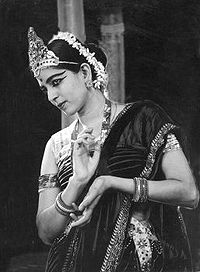
Rukmini Devi Arundale is considered the most important revivalist in the Indian classical dance form of Bharata Natyam from its original 'sadhir' style
Other Tamil folk dances include mayilāṭṭam, where the dancers tie a string of peacock feathers around their waist; ōyilāttam, danced in a circle while waving small pieces of cloth of various colours; poikkal kuthiraiyaaṭṭam, where the dancers use dummy horses; manattam, where the dancers imitate the graceful leaping of deer; paraiyāṭṭam, a dance to the sound of rhythmical drumbeats, and thīppandāṭṭam, a dance involving playing with burning wooden torches.
Bharatanatyam is a classical dance form originating from Tamil Nadu. Prior to the colonial period, it used to be performed in Hindu temples by Devadasis. In this form, it as also been called sadir or chinna melam. Many of the ancient sculptures in Hindu temples are based on Bharata Natyam dance postures. Bharatanatyam is a traditional dance-form known for its grace, purity, tenderness, and sculpturesque poses. It continues to be a popular dance style at present times and is practised by male and female dancers all over India. Terukkuttu or Kattaikkuttu is a traditional form of Tamil street theatre folk dance/drama.

A scene from the Tamil film Chandralekha (1948)
Film industry
Main article: Tamil cinema
Tamil Nadu is also home to the Tamil film industry also known as
"Kollywood", which released the most number of films in India in 2013.[106] The term Kollywood is a portmanteau of Kodambakkam and Hollywood.[107] Tamil cinema is one of the largest centres of film production in India.[108] In Tamil Nadu, cinema ticket prices are regulated by the government. Single screen theaters may charge a maximum of ₹50, while theaters with more than three screens may charge a maximum of ₹120 per ticket.[109] The first silent film in Tamil Keechaka Vadham, was made in 1916.[110] The first talkie was a multi-lingual, Kalidas, which released on 31 October 1931, barely 7 months after India's first talking picture Alam Ara[111] Swamikannu Vincent, who had built the first cinema of South India in Coimbatore,
introduced the concept of "Tent Cinema" in which a tent was erected on a
stretch of open land close to a town or village to screen the films.
The first of its kind was established in Madras,
called "Edison's Grand Cinemamegaphone". This was due to the fact that
electric carbons were used for motion picture projectors.[112]Television industry
There are more than 30 television channels of various genre in Tamil. DD Podhigai, Doordarshan's Tamil language regional channel was launched on April 14, 1993.[113] The first private Tamil channel, Sun TV was founded in 1993 by Kalanidhi Maran. In Tamil Nadu, the television industry is influenced by politics and majority of the channels are owned by politicians or people with political links.[114] The government of Tamil Nadu distributed free televisions to families in 2006 at an estimated cost ₹3.6 billion (US$54 million) of which has led to high penetration of TV services.[115][116] Cable used to be the preferred mode of reaching homes controlled by government run operator Arasu Cable.[117] From the early 2010s, Direct to Home has become increasingly popular replacing cable television services.[118] Tamil television serials form a major prime time source of entertainment and are directed usually by one director unlike American television series, where often several directors and writers work together.[119]
TIDEL Park, Coimbatore; Coimbatore is one of the leading BPO centers in India
Cuisine
Main article: Tamil cuisine
Tamil cuisine is typical of south Indian cuisine, in that rice and rice-derived dishes form the major portion of a diet (see rice and curry). There are regional sub-varieties namely Chettinadu, Kongunadu, Madurai, Tirunelveli varieties etc. Traditionally, food is served on a banana leaf instead of a plate and eaten with the right hand.Rice is the staple food of Tamils and is typically eaten mixed with sambhar (with or without ghee), vegetarian or non-vegetarian kulambu, rasam, curd and buttermilk. This is accompanied with various vegetarian and/or non-vegetarian dishes like kootu, aviyal, poriyal, appalam, varuval, peratal, kothsu, varieties of pickles and chicken, mutton, or fish fry.
Breakfast and snack items include dosai, adai, idly, vadai, pongal, aappam, paniyaram, puttu, uppuma, santhakai, idiyappam and uthappam. These items are eaten along with sambar, varieties of chatni or podi (spice powder). Traditionally prepared filter coffee is unique in taste and popular all over the state. The Chettinad region is famous for its spicy non-vegetarian cuisine, while Ambur and Dindigul are known for their Biriyani. Sweet items that are native to Tamil Nadu are athirasam, Chakkarai Pongal and Kuli Paniyaram. Salem is renowned for its unique mangoes, Madurai is the place of origin of milk dessert Jigarthanda while Palani is known for its Panchamirtham.[120]
Economy
Main articles: Economy of Tamil Nadu, List of conglomerates in Tamil Nadu and List of rivers of Tamil Nadu
Tamil Nadu is the second largest contributor to India's GDP. For the year 2014-15 Tamil Nadu's GSDP was ₹9767 billion (US$150 billion), and growth was 14.86.[121] It ranks third in foreign direct investment (FDI) approvals (cumulative 1991–2002) of ₹
225,826 million ($5,000 million), next only to Maharashtra and Delhi
constituting 9.12 per cent of the total FDI in the country.[122] The per capita income in 2007–2008 for the state was ₹ 72,993 ranking third among states with a population over 10 million and has steadily been above the national average.[123]| Year | GSDP | Growth Rate | Share in India |
|---|---|---|---|
| 2000–01 | 142,065 | 5.87% | 7.62% |
| 2001–02 | 139,842 | −1.56% | 7.09% |
| 2002–03 | 142,295 | 1.75% | 6.95% |
| 2003–04 | 150,815 | 5.99% | 6.79% |
| 2004–05 | 219,003 | 11.45% | 7.37% |
| 2005–06 | 249,567 | 13.96% | 7.67% |
| 2006–07 | 287,530 | 15.21% | 8.07% |
| 2007–08 | 305,157 | 6.13% | 7.83% |
| 2008–09 | 321,793 | 5.45% | 7.74% |
| 2009–10 | 356,632 | 10.83% | 7.89% |
| 2010–11 | 403,416 | 13.12% | 8.20% |
| 2011–12 | 433,238 | 7.39% | 8.26% |
| 2012–13 | 447,944 | 3.39% | 8.17% |
| 2013–14 | 480,618 | 7.29% | 8.37% |
Agriculture
Tamil Nadu has historically been an agricultural state and is a leading producer of agricultural products in India. In 2008, Tamil Nadu was India's fifth biggest producer of rice. The total cultivated area in the State was 5.60 million hectares in 2009–10.[126] The Cauvery delta region is known as the Rice Bowl of Tamil Nadu.[127] In terms of production, Tamil Nadu accounts for 10 per cent in fruits and 6 per cent in vegetables, in India.[128] Annual food grains production in the year 2007–08 was 10035,000 mt.[126] Mango and banana are the leading fruit crops in Tamil Nadu accounting for over 87 per cent of the total fruit production. The main vegetables grown are tapioca, tomato, onion, brinjal (eggplant), and drumstick. Tamil Nadu is also a leading state in the production of flowers with the total production of horticultural crops standing at ₹ 9947,000 during 2003–04. The main flowers grown in Tamil Nadu are jasmine, chrysanthemum, marigold and rose.The state is the largest producer of bananas, turmeric, flowers,[128] tapioca,[128] the second largest producer of mango,[128] natural rubber,[129] coconut, groundnut and the third largest producer of coffee, sapota,[128] Tea[130] and Sugarcane. Tamil Nadu's sugarcane yield per hectare is the highest in India. The state has 17,000 hectares of land under oil palm cultivation, the second highest in India.[131]
Dr M.S. Swaminathan, known as the "father of the Indian Green Revolution" was from Tamil Nadu.[132] Tamil Nadu Agricultural University with its seven colleges and thirty two research stations spread over the entire state contributes to evolving new crop varieties and technologies and disseminating through various extension agencies. Among states in India, Tamil Nadu is one of the leaders in livestock, poultry and fisheries production. Tamil Nadu had the second largest number of poultry amongst all the states and accounted for 17.7 per cent of the total poultry population in India.[133] In 2003–2004, Tamil Nadu had produced 3783.6 million of eggs, which was the second highest in India representing 9.37 per cent of the total egg production in the country.[134] With the third longest coastline in India, Tamil Nadu represented 27.54 per cent of the total value of fish and fishery products exported by India in 2006.
Textiles and leather

Kanchipuram hand loom silk sarees
The state accounts for 70 per cent of leather tanning capacity in India and 38 per cent of leather footwear and components. The exports from Tamil Nadu are valued at about US $762 million, which accounts for 42 per cent of Indian leather exports. Hundreds of leather and tannery industries are located around Vellore, Dindigul and Erode its nearby towns such as Ranipet, Ambur, Perundurai and Vaniyambadi.
Automobiles
Tamil Nadu has seen major investments in the automobile industry over many decades manufacturing cars, railway coaches, battle-tanks, tractors, motorcycles, automobile spare parts and accessories, tyres and heavy vehicles. Chennai is known as the Detroit of India.[140] Major global automobile companies including BMW, Ford, Robert Bosch, Renault-Nissan, Caterpillar, Hyundai, Mitsubishi Motors, and Michelin as well as Indian automobile majors like Mahindra & Mahindra, Ashok Leyland, Hindustan Motors, TVS Motors, Irizar-TVS, Royal Enfield, MRF, Apollo Tyres, TAFE Tractors, DaimlerChrysler AG Company also invested (₹) 4 billion for establishing new plant in Tamil Nadu.[141] Karur is a hub for Bus body building industries.Heavy industries and engineering
Tamil Nadu is one of the highly industrialized states in India. Over 11% of the S&P CNX 500 conglomerates have corporate offices in Tamil Nadu. Many heavy engineering and manufacturing companies are located in and around the suburbs of Chennai. Bharat Heavy Electricals, one of India's largest electrical equipment manufacturing companies, has manufacturing plants at Tiruchirapalli and Ranipet. India's leading steel producer, the state-owned Steel Authority of India has a steel plant in Salem. Sterlite Industries has a copper smelter at Tuticorin and an aluminium plant in Mettur. The Chennai Petroleum Corporation is a state-owned oil and gas corporation headquartered in Chennai, and owns refineries at Manali and Panangudi. The state government owns the Tamil Nadu Newsprint and Papers,[142] in Karur. Jointly with the Tata Group, the state owns the world's sixth largest manufacturer of watches, under the brand name of Titan, at Hosur. A number of large cement manufacturers, including the Chettinad Group, Ramco Cements, Tancem, the Dalmia Group, UltraTech Cements and ACC are present across the state.Coimbatore is also referred to as "the Pump City" as it supplies two thirds of India's requirements of motors and pumps. The city is one of the largest exporters of wet grinders and auto components and the term "Coimbatore Wet Grinder" has been given a Geographical indication.[143]

Mahindra World City near Chennai
Electronics and software
Electronics manufacturing is a growing industry in Tamil Nadu, with many international companies like Nokia, Flextronics, Motorola, Sony-Ericsson, Foxconn, Samsung, Cisco, Moser Baer and Dell having chosen Chennai as their south Asian manufacturing hub. Products manufactured include circuit boards and cellular phone handsets.[144]Tamil Nadu is the second largest software exporter by value in India. Software exports from Tamil Nadu grew from ₹ 76 billion ($1.6 billion) in 2003–04 to ₹ 207 billion {$5 billion} by 2006–07 according to NASSCOM[145] and to ₹ 366 billion in 2008–09 which shows 29 per cent growth in software exports according to STPI. Major national and global IT Companies such as Syntel, Infosys, Wipro, HCL, Tata Consultancy Services, Verizon, Hewlett-Packard, Amazon.com, eBay, Paypal, IBM, Accenture, Ramco Systems, Computer Sciences Corporation, Cognizant Technology solutions, Tech Mahindra, Polaris, Aricent, MphasiS, MindTree, Hexaware Technologies and many others have offices in Tamil Nadu. The top engineering colleges in Tamil Nadu have been a major recruiting hub for the IT firms. According to estimates, about 50 per cent of the HR required for the IT and ITES industry was being sourced from the State.[146] Coimbatore is the second largest software producer in the state, next to Chennai.[147]
Others
Namakkal is also one of the major centers of Egg production in India. Coimbatore is one of the major centers of jewellery and poultry.[148][149] Karur is also the major manufacturer of Nylon nets (HDPE) filaments. Sivakasi is a major centre of fireworks and safety match production and offset printing in India with over 60 per cent of firework production in India. Kanyakumari is famous for rubber production. Armoured Vehicles and Ammunition Depot of India (AVADI) which manufactures armored vehicles for Indian military is located about 23 km northwest of Chennai. Integral Coach Factory in Perambur is the largest producer of railway coaches in Asia.Infrastructure
Transport
Road

Chennai International Airport, one of the major international airports in the country

Pamban road (left) and rail (right) bridges, connecting the Indian mainland with the Pamban Island
Main articles: Transport in Tamil Nadu and Road network in Tamil Nadu
Tamil Nadu has a transportation system that connects all parts of the
state. Tamil Nadu is served by an extensive road network, providing
links between urban centres, agricultural market-places and rural areas.
There are 29 national highways in the state, covering a total distance
of 5,006.14 km (3,110.67 mi).[150][151] The state is also a terminus for the Golden Quadrilateral project, that connects four major metropolitan cities in India (Delhi, Mumbai, Chennai, Kolkata).
The state has a total road length of 167,000 km (104,000 mi), of which
60,628 km (37,672 mi) are maintained by Highways Department. This is
nearly 2.5 times higher than the density of all-India road network.[152] The major road junctions are Chennai, Salem
Madurai, Trichy, Coimbatore, Tirunelveli, Tuticorin, Karur,
Krishnagiri, Dindigul, Kanniyakumari. Road transport is provided by
state owned Tamil Nadu State Transport Corporation and State Express Transport Corporation.
Almost every part of state is well connected by buses 24 hours a day.
The State accounted for 13.6 per cent of all accidents in the country
With 66,238 accidents in 2013, 11.3 per cent of all road accident deaths
and 15 per cent of all road-related injuries, according to data
provided by the Ministry of Road Transport and Highways. Although Tamil
Nadu accounts for the highest number of road accidents in India, it also
leads in having reduced the number of fatalities in accident-prone
areas with deployment of personnel and a sustained awareness campaign.
The number of deaths at areas decreased from 1,053 in 2011 to 881 in
2012 and 867 in 2013.[153]Rail
Tamil Nadu has a well-developed rail network as part of Southern Railway. Headquartered at Chennai, the Southern Railway network extends over a large area of India's southern peninsula, covering the states of Tamil Nadu, Kerala, Puducherry, a small portion of Karnataka and a small portion of Andhra Pradesh. Express trains connect the state capital Chennai with Mumbai, Delhi, and Kolkatta. Chennai Central is gateway for train towards north whereas Chennai Egmore serves as gateway for south. Tamil Nadu has a total railway track length of 5,952 km (3,698 mi) and there are 532 railway stations in the state. The network connects the state with most major cities in India. The Nilgiri Mountain Railway is one of the UNESCO World Heritage Site connecting Ooty on the hills and Mettupalayam in the foot hills which is in turn connected to Coimbatore city. The centenary old Pamban Bridge over sea connecting Rameswaram in Pamban island to mainland is an engineering marvel. It is one of the oldest cantilever bridges still in operation, the double-leaf bascule bridge section can be raised to let boats and small ships pass through Palk Strait in Indian Ocean. Chennai has a well-established suburban railway network and is constructing a Chennai Metro. Major railway junctions( 4 & above lines ) in the state are Chennai, Coimbatore, Madurai, Salem, Erode, Dindigul, Karur, Nagercoil, Tiruchirapalli and Tirunelveli. Chennai Central, Chennai Egmore, Salem Junction, Tiruchirappalli Junction, Madurai Junction, Coimbatore Junction are upgraded to A1 grade level. Loco sheds are located at Erode, Arakkonam, Royapuram in Chennai and Tondaiyarpet in Chennai, Ponmalai (GOC) in Tiruchirappalli as Diesel Loco Shed. The loco shed at Erode is a huge composite Electric and Diesel Loco shed. MRTS which covers from Chennai Beach to VelacheryAirports
The first flight in the country was from Mumbai to Chennai. Tamil Nadu has 4 international airports at Chennai, Coimbatore, Tiruchirapalli and Madurai and a domestic terminal in Chennai called "Kamaraj Terminal" while other two domestic airports are at Tuticorin and Salem. Chennai's Anna International Airport is a major international airport that is connected with 19 countries with more than 169 direct flights every week. This is the third largest airport in India after Mumbai and Delhi and has a passenger growth of 18 per cent. Other international and customs airports present in the state are Coimbatore International Airport, Tiruchirapalli International Airport and Madurai Airport. Salem Airport and Tuticorin Airport are domestic airports with daily flights. Increased industrial activity has given rise to an increase in passenger traffic as well as freight movement which has been growing at over 18 per cent per year. Besides civilian airports, Tamil Nadu also hosts four air bases for the Indian Air Force at Thanjavur, Tambram, Sulur and Madurai; and two naval air stations INS Rajali and INS Parundu for Indian Navy.Seaport
Tamil Nadu has three major seaports located at Chennai, Ennore and Tuticorin, as well as seven other minor ports including Cuddalore and Nagapattinam.[126] Chennai Port is an artificial harbour situated on the Coromandel Coast and is the second principal port in the country for handling containers. Ennore Port handles all the coal and ore traffic in Tamil Nadu. The volume of cargo in the ports grew by 13 per cent during 2005.[154]Energy
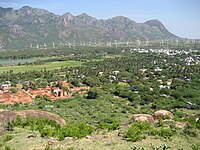
Wind farm in Muppandal and Aralvaimozhi region
Sports
Main article: Sports in Tamil Nadu

Jallikattu bull taming festival near Madurai

Viswanathan Anand, world chess champion 2007–2013
The most popular game in Tamil Nadu like rest of India is Cricket. The M. A. Chidambaram Stadium in Chennai is an international cricketing arena with a capacity of 50,000 and houses the Tamil Nadu Cricket Association.[165] Srinivasaraghavan Venkataraghavan,[166] Krishnamachari Srikkanth,[167] Laxman Sivaramakrishnan,[168] Laxmipathy Balaji,[169] Murali Vijay,[170] Ravichandran Ashwin[171] and Dinesh Karthik are someprominent cricketers from Tamil Nadu. The MRF Pace Foundation in Chennai, headed by Australian bowler Glenn Mcgrath is a popular fast bowling academy for pace bowlers all over the world. Cricket contests between local clubs, franchises and teams are popular in the state. Chennai Super Kings represents Chennai among the eight Indian cities featuring in the Indian Premier League, a popular Twenty-20 cricket competition. Chennai super kings captained by Mahendra Singh Dhoni is the most successful Franchise with two IPL titles and two champions league T20 title. Chennai super kings is the only team to make entry into the finals of the prestigious Indian premier league for six times.

Kari Motor Speedway in Coimbatore
Tennis is also a popular sport in Tamil Nadu with notable international players including Ramesh Krishnan,[172] Ramanathan Krishnan,[172] Vijay Amritraj[173] and Mahesh Bhupathi. Nirupama Vaidyanathan, the first Indian women to play in a grandslam tournament also hails from the state. The ATP Chennai Open tournament is held in Chennai every January. The Sports Development Authority of Tamil Nadu (SDAT) owns Nungambakkam tennis stadium which hosts Chennai Open and Davis Cup play-off tournaments.
Five time World Chess champion Viswanathan Anand hails from Tamil Nadu. The state boasts a total of eight Grand Masters and numerous International Masters. Other notable chess players from the state include Manuel Aaron, the first Indian International Master,G.Akash, the youngest Indian to win a national tournament, Krishnan Sasikiran, Grandmaster, S. Vijayalakshmi, Six time Women's national champion of India and the First Women Grandmaster from India, Aarthie Ramaswamy, Women Grandmaster and former under-18 girls' World Chess champion. Maria Irudayam, the former World Carrom Champion and Ilavazhagi, the defending Women's World Carrom Champion are from Tamil Nadu.
The Tamil Nadu Hockey Association is the governing body of Hockey in the state. Vasudevan Baskaran was the captain of the Indian team that won gold medal in 1980 Olympics at Moscow. The Mayor Radhakrishnan Stadium in Chennai hosts international hockey events and is regarded by the International Hockey Federation as one of the best in the world for its infrastructure.[174]
The Sports Development Authority of Tamil Nadu (SDAT), a government body, is vested with the responsibility of developing sports and related infrastructure in the state.[175] The SDAT owns and operates world class stadiums and organises sporting events.[176] It also accommodates sporting events, both at domestic and international level, organised by other sports associations at its venues. The YMCA College of Physical Education at Nandanam in Chennai was established in 1920 and was the first college for physical education in Asia. The Jawaharlal Nehru Stadium in Chennai is a multi-purpose stadium hosting football and track & field events. The Indian Triathlon Federation and the Volleyball Federation of India are headquartered in Chennai. Chennai hosted India's first ever International Beach Volleyball Championship in 2008. The SDAT – TNSRA Squash Academy in Chennai is one of the very few academies in south Asia hosting international squash events.
Snooker was invented by General Sir Frederick Roberts at the Ooty Club in Ooty, a hill station in the state. Tamil Nadu has six 18-hole golf courses, the most popular of which are Kodaikanal Golf Club, established in 1895, Ooty Golf Course, established in 1896, and Gymkhana Club, Chennai. The Madras Boat Club, set up in 1867, hosts regular rowing races on the Adyar River. The Guindy race course in Chennai, set up in 1777, is the oldest horse racing venue in India. Adventure sports have gained popularity, especially amongst the tourists visiting the state.
Tourism
Main article: Tourism in Tamil Nadu
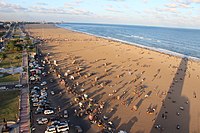
Marina Beach, the longest urban beach in the country
Madurai Meenakshi Amman Temple, Sri Ranganathaswamy Temple, Srirangam, Tiruchirappalli is the largest functioning temple in the Tamil Nadu, Rameshwaram whose temple walk-ways corridors are the longest 1.2 km (0.75 mi) of all Indian temples, Chidambaram, Thiruvannaamalai, Kanchipuram and Six Abodes of Murugan are amongst the important pilgrimage sites for Hindus. Other popular temples in Tamil Nadu include those in Tiruvarur, Kumbakonam, Sankarankovil, Srivilliputhur, Tiruttani, Namakkal, Vellore, Karur, Bhavani, Pariyur, Bannari, Chennai, Coimbatore and Kanniyakumari.
Tamil Nadu is also home to hill stations like Udhagamandalam (Ooty), Kodaikanal, Yercaud, Coonoor, Topslip, Valparai and Yelagiri. The Nilgiri hills, Palani hills, Shevaroy hills, Kolli Hills and Cardamom hills are all abodes of thick forests and wildlife. Tamil Nadu has many national parks, biosphere reserves, wildlife sanctuaries, elephant and bird sanctuaries, reserved forests, zoos and crocodile farms. Prominent among them are Mudumalai National Park, The Gulf of Mannar Biosphere Reserve, Anaimalai Wildlife Sanctuary, Vedanthangal Bird Sanctuary and Arignar Anna Zoological Park.[181] The mangrove forests at Pichavaram are also eco-tourism spots of importance. The prominent waterfalls in the state are Courtallam, Hogenakkal, Papanasam, Manimuthar, Thirparappu, Pykara and Silver Cascade. The Chettinad region of the state is renowned for its palatial houses and cuisine. With cheap and quality tertiary medical care available in Chennai, Coimbatore, Madurai and Vellore, Tamil Nadu has the largest numbers in medical tourism in India. Kanyakumari, the southernmost tip of peninsular India, is famous for its beautiful sunrise, Vivekananda Rock Memorial and Thiruvalluvar's statue built off the coastline. Marina Beach in Chennai is one of the longest beaches in the world. The stretch of beaches from Chennai to Mahabalipuram are home to many resorts, theme parks and eateries.
-
-
The Corridor of 1000 pillars inside Rameswaram Temple
-
The Dolphin's Nose at Kodaikanal
-
-
Jambukeswarar Temple, Thiruvanaikaval
-








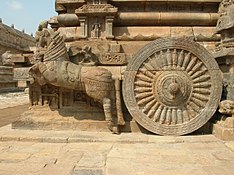

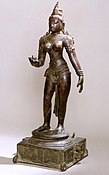

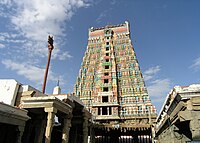
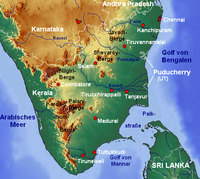

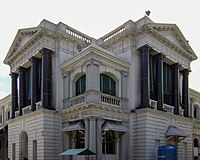










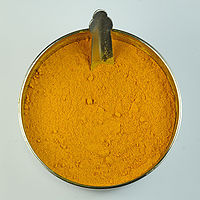











Wonderful blog explain about Tamilnadu symbols and traditions..Breaking Tamilnadu Politics
ReplyDeletegreat to see this blog. also add to visit Cruise in Goa at Champions Yacht Club.
ReplyDeleteThanks for sharing such beautiful information. I hope you will share some more information and Please keep sharing.
ReplyDeleteValley of Flowers Trek Cheapest Package details with Himalayan Climber
https://www.himalayanclimber.com/tours/valley-of-flowers/
https://www.himalayanclimber.com
Beautiful blog. Kindly Visit My Holiday Happiness website for tour packages.
ReplyDelete